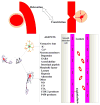Controversies and evolving new mechanisms in subarachnoid hemorrhage
- PMID: 24076160
- PMCID: PMC3961493
- DOI: 10.1016/j.pneurobio.2013.09.002
Controversies and evolving new mechanisms in subarachnoid hemorrhage
Abstract
Despite decades of study, subarachnoid hemorrhage (SAH) continues to be a serious and significant health problem in the United States and worldwide. The mechanisms contributing to brain injury after SAH remain unclear. Traditionally, most in vivo research has heavily emphasized the basic mechanisms of SAH over the pathophysiological or morphological changes of delayed cerebral vasospasm after SAH. Unfortunately, the results of clinical trials based on this premise have mostly been disappointing, implicating some other pathophysiological factors, independent of vasospasm, as contributors to poor clinical outcomes. Delayed cerebral vasospasm is no longer the only culprit. In this review, we summarize recent data from both experimental and clinical studies of SAH and discuss the vast array of physiological dysfunctions following SAH that ultimately lead to cell death. Based on the progress in neurobiological understanding of SAH, the terms "early brain injury" and "delayed brain injury" are used according to the temporal progression of SAH-induced brain injury. Additionally, a new concept of the vasculo-neuronal-glia triad model for SAH study is highlighted and presents the challenges and opportunities of this model for future SAH applications.
Keywords: Delayed brain injury; Early brain injury; Subarachnoid hemorrhage; Vasculo-neuronal-glia triad model; Vasospasm.
Copyright © 2013 Elsevier Ltd. All rights reserved.
Conflict of interest statement
Figures





References
-
- Addae JI, Ali N, Stone TW. Effects of AMPA and clomethiazole on spreading depression cycles in the rat neocortex in vivo. Eur J Pharmacol. 2011;653:41–46. - PubMed
-
- Ahmad I, Imaizumi S, Shimizu H, Kaminuma T, Ochiai N, Tajima M, Yoshimoto T. Development of calcitonin gene-related peptide slow-release tablet implanted in CSF space for prevention of cerebral vasospasm after experimental subarachnoid haemorrhage. Acta Neurochir (Wien) 1996;138:1230–1240. - PubMed
-
- Aihara Y, Jahromi BS, Yassari R, Nikitina E, Agbaje-Williams M, Macdonald RL. Molecular profile of vascular ion channels after experimental subarachnoid hemorrhage. J Cereb Blood Flow Metab. 2004;24:75–83. - PubMed
-
- Aihara Y, Kasuya H, Onda H, Hori T, Takeda J. Quantitative analysis of gene expressions related to inflammation in canine spastic artery after subarachnoid hemorrhage. Stroke. 2001;32:212–217. - PubMed
Publication types
MeSH terms
Grants and funding
LinkOut - more resources
Full Text Sources
Other Literature Sources

